Introduction
Profitable crop production depends on effective weed control. Weeds can reduce crop yield potential by competing for water, nutrients, and light. Although rare, some weeds release toxins that inhibit crop growth, and others may harbour insects, diseases, or nematodes that attack crops. Weeds can also reduce harvest efficiency and produce seed that can impact future crops.
Not all weeds compete with crops equally.1 Canopy closure of the crop can limit the competitive ability of weeds. Early-germinating weeds are generally more competitive than weeds that emerge later in the growing season. Fields that experience moisture stress are also at greater risk of yield losses from weed competition.
Late-emerging weeds emerge after control tactics have been implemented. The competitiveness of late-emerging weeds is strongly influenced by how quickly the crop canopy develops. Stress factors that reduce crop growth can increase the impact of late-emerging weeds. These weeds are at a competitive disadvantage to the crop due to their delayed emergence but are still capable of causing economic losses and contributing to the weed seed bank.
Late-emerging weeds should not be ignored because they can produce significant quantities of seed. If weeds have not initiated seed set at the time of herbicide application, seed production should be eliminated or reduced. However, if the fruiting structures are visible, it is unlikely that the application will reduce weed seed production or viability of the seeds. The other benefit of late season weed control is harvest efficiency, and there are situations where these applications may be worthwhile.
Effective weed control in field crops requires the use of multiple management techniques including mechanical, cultural, and chemical methods. Continuous cropping and utilizing the same weed control techniques encourages the development of problem weeds and potentially, herbicide resistance. Crop rotation, tillage, and a diversified herbicide portfolio helps reduce this problem.
Proper weed identification is an essential first step in a weed management plan. Broadleaf weeds can often be identified by the shape of the leaves or cotyledons. For grass weeds precise identification may involve looking closely at the ligule and collar region (Figure 1). Given that grass weed management is most effective when weeds are small, a hand or pocket lens with 10X magnification can improve grass weed identification. Grass leaves are either rolled or flat within the stem. Ligules of grasses will either be absent, hairy, or membranous (Figure 2). Auricles will either be present or absent. Below are descriptions and pictures to aid in identifying some of the common grass species found in agronomic crops as well as management of these species.
 Figure 1. Grass identification characteristics.
Figure 1. Grass identification characteristics.
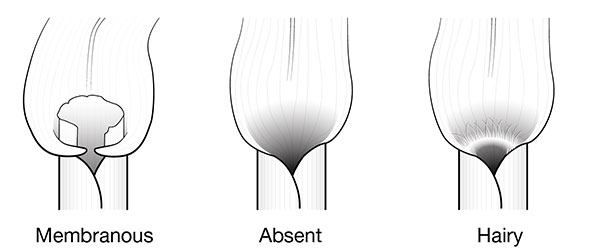 Figure 2. Grass ligule types.
Figure 2. Grass ligule types.
This document will identify some of the most prevalent weeds impacting management decisions for farmers in Western Canada. Weeds are grouped in two sections, primary and secondary influencers, based on their impact to crop management. Within these groups, weeds are organized by prevalence across the Prairies based on recent weed surveys.
Primary Influencers
- Wild oats
- Cleavers
- Kochia
Secondary Influencers
- Green foxtail
- Wild buckwheat
- Volunteer canola
- Lamb’s-quarters
- Canada thistle
- Spiny annual sow thistle
- Dandelion
- Narrow-leaved hawk’s beard
- Chickweed
- Barnyard grass
Sources:
1 VanGessel, M. Weed management in row crops: application to corn production - competitive index factor chart. Northeast IPM Module number 10. http://northeastipm.org.
Common name: Wild oats
Scientific name: Avena fatua
Life Cycle:Annual
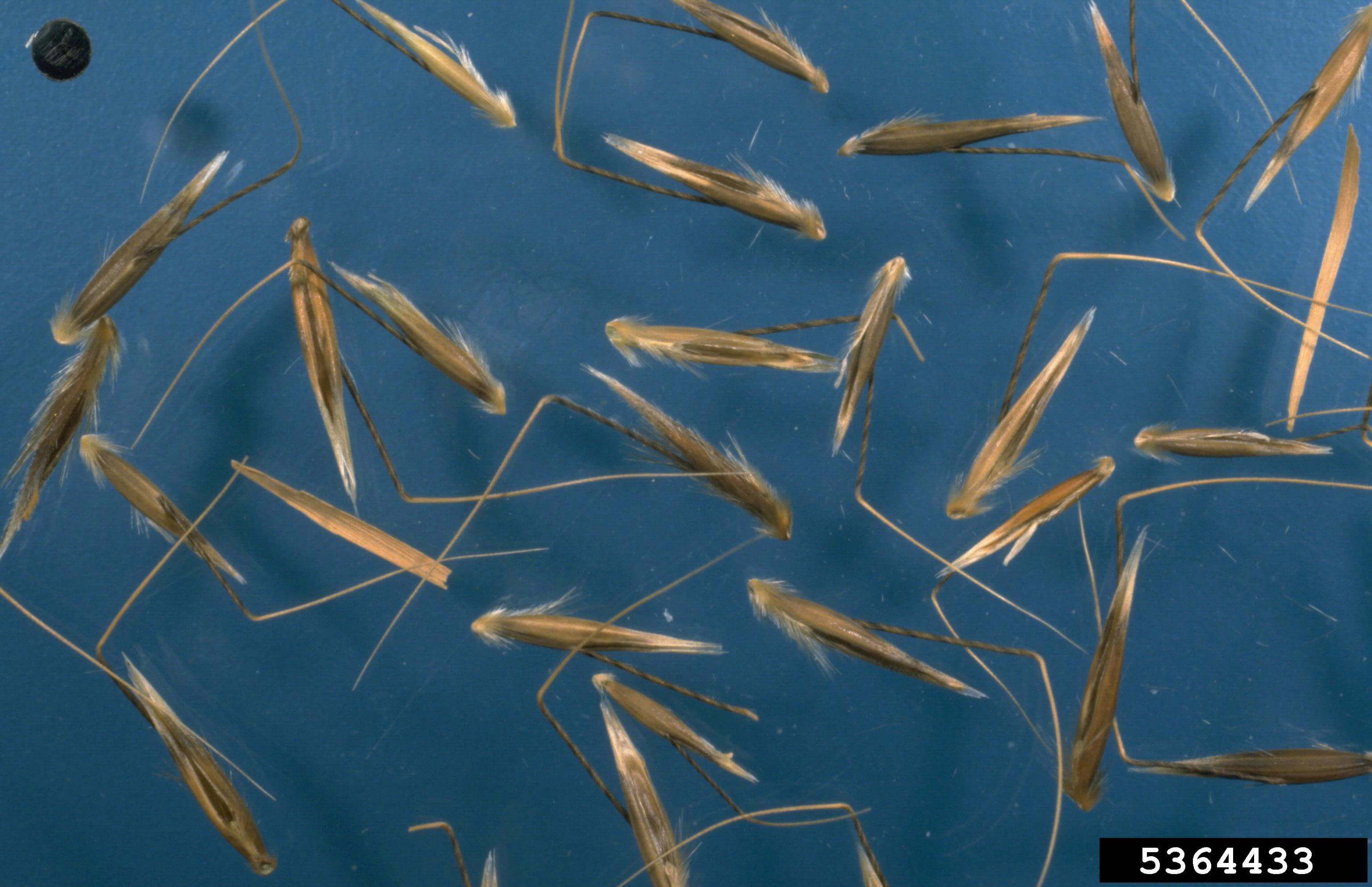 Figure 3. Wild oat seeds. Howard F. Schwartz, Colorado State University, Bugwood.org
Figure 3. Wild oat seeds. Howard F. Schwartz, Colorado State University, Bugwood.org
 Figure 4. Wild oat panicle above crop canopy. Jan Samanek, Phytosanitary Administration, Bugwood.org
Figure 4. Wild oat panicle above crop canopy. Jan Samanek, Phytosanitary Administration, Bugwood.org
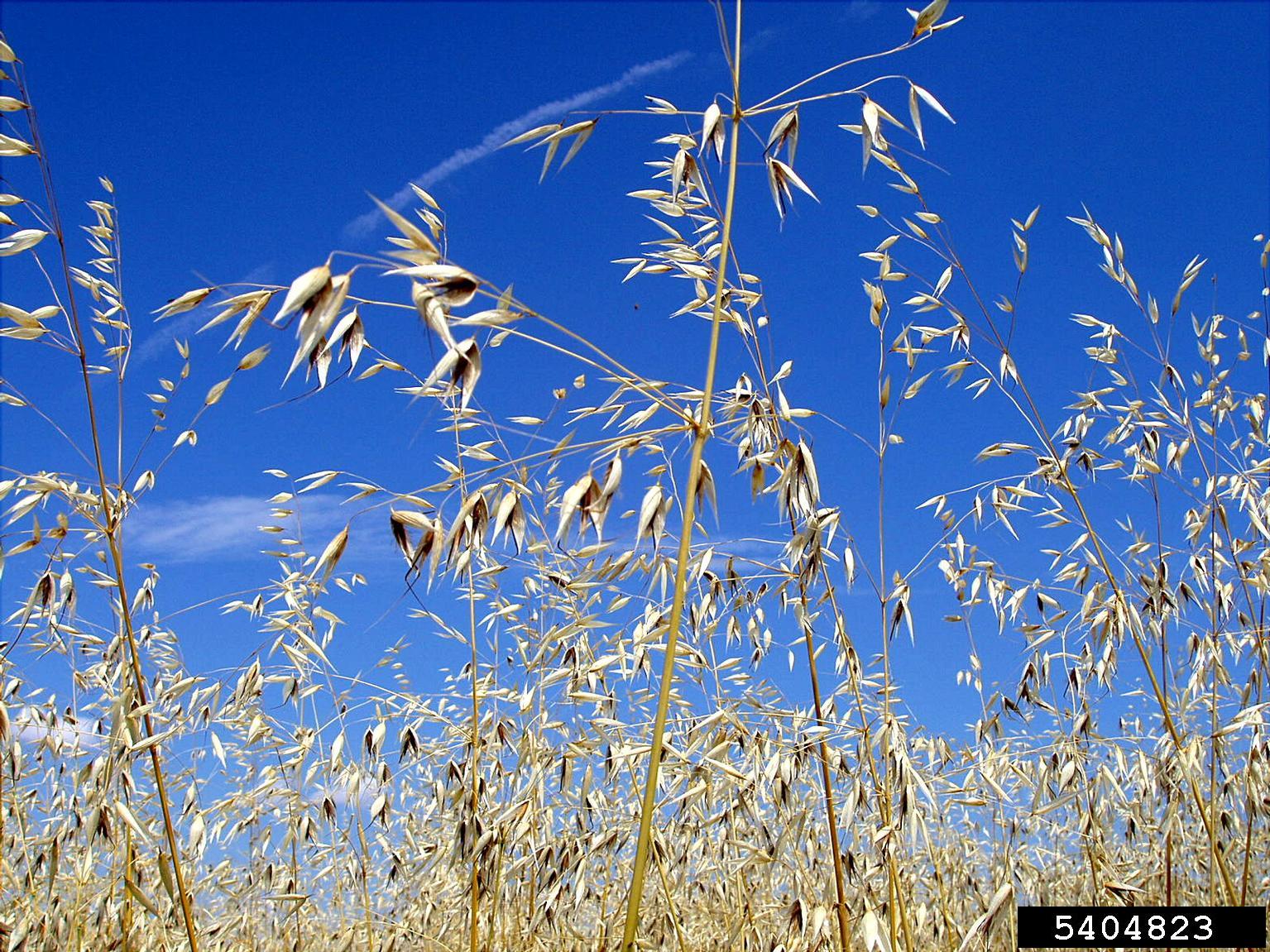 Figure 5. Wild oats at maturity. Jan Samanek, Phytosanitary Administration, Bugwood.org
Figure 5. Wild oats at maturity. Jan Samanek, Phytosanitary Administration, Bugwood.org
Reason for concern: Chickweed is of particular concern in Alberta where it is ranked 1st for relative abundance.1 Chickweed is also increasing in relative abundance in Manitoba, though in Manitoba and Saskatchewan it is ranked 18th.2,3 Group 2 (ALS inhibitor) resistant chickweed grows in all Prairie Provinces.4
Identification: Wild oats are annual weeds that germinate in spring and fall. Wild oats look very similar to cultivated oats. In the spring, the best way to distinguish the weed is by digging up the plant and finding the seed attached to the roots. Wild oat seeds can vary in colour but can be dark while tame oats are usually beige. The key identifying feature on wild oat seeds is the bent twisted awn (Figure 3). Wild oat plants have a high membranous ligule, and no auricles. Hairs can be found on the leaf margin. The seed head is a panicle which tends to be larger and more drooping than the tame oats (Figure 4). Wild oats are often taller than the crop. At maturity, the straw and chaff are whiter than tame oats (Figure 5).4
Seeds typically survive for 4 to 5 years in the soil.4 A single plant commonly produces 100 to 150 seeds. Wild oats typically drop their seed prior to crop harvest. The heavy seeds drop near the plant and do not naturally move great distances.5
Management: Herbicide options are limited where resistance is present. Know what biotypes are present on your farm to help guide management decisions. There are no in-crop herbicide options in wheat or barley where multiple resistance to Group 1 and 2 herbicides is present. Consider tank-mixing or layering multiple effective modes of action prior to the crop. Crop rotation is important to manage herbicide resistance. For example, canola offers an option to use a Group 9 (glyphosate) or Group 10 (glufosinate) herbicide in-crop with the respective resistance traits.
Wild oat growth can be limited with cultural practices such as crop rotation with non-cereal crops, increasing seeding rate, and variety selection of the cereal crop. Doubling the seeding rate of barley can result in 4 times the reduction in wild oat seed production. Selecting a more competitive variety (taller) can result in 2 times a reduction in wild oat seed production. These factors combined can reduce wild oat seed production by 10 times. When these management practices are used with a crop rotation (barley-canola-barley-peas in this study), wild oat seed production can be reduced by 37 times.6
Consideration for the biology of the weed must be taken when determining a management strategy. Wild oats typically shed seed earlier than crops (wheat or canola) are harvested. In this case, seed is returned to the soil seed bank. In contrast, where the crop is harvested early (such as barley), wild oat seed may be moved across the field as it is taken into the combine. In this case, a seed destructor behind the combine may be considered to destroy seed and prevent it from spreading or returning to the seed bank.
Where resistance occurs, patch management may be an option to slow the spread. Preventing seed shed can reduce viable seed bank density by 90% the following year.5 Options include mowing down or cutting for livestock feed prior to seed set. If seed has already set, mowing will not prevent seed return to the seed bank but can help contain the patch so that seeds are not spread around the field with other equipment operations. At harvest, when wild oats have set seed, consider dropping the straw rather than spreading chaff (and weed seed) over a larger area. Bale or burn to remove the straw for the following crop.7
Sources:
1 Leeson, J., Gaultier, J., Hall, L., Neeser, C. Residual Weed Population Shifts in the Prairie Provinces 1973 to 2017. Agriculture and Agri-Food Canada.
2 Resistant wild oat action committee. 2020. Wild oat resistance in the Canadian Prairies. https://weedscience.ca/wild-oat-action-committee/.
3 Heap, I. 2021. International Herbicide-resistant weed database. www.weedscience.org.
4 Beckie, H., Francis, A., Hall, L.M. 2012. The Biology of Canadian Weeds. 27. Avena fatua L. (updated) Canadian Journal of Plant Science, Vol. 92 pp. 1329-1357. https://cdnsciencepub.com/doi/10.4141/cjps2012-005 .
5 Beckie, H., Hall, L., Schuba, B. 2005. Patch Management of Herbicide-resistant wild oat (Avena fatua). Weed Technology. Vol. 19pp. 697-705. https://doi.org/10.1614/WT-04-222R.1.
6 Beckie, H. Wild oat herbicide resistance: few active groups left. [Presentation]
https://www1.agric.gov.ab.ca/
7 Resistant wild oat action committee. Stop the spread! https://weedscience.ca/wild-oat-action-committee/.
Web links verified 4/22/2021
Common name: Cleavers/False cleavers
Scientific name: Galium aparine/Galium spurium
Life Cycle: Winter annual/annual
 Figure 6. Prostrate growth of cleavers. Photo courtesy of Bruce Ackley, The Ohio State University, Bugwood.org
Figure 6. Prostrate growth of cleavers. Photo courtesy of Bruce Ackley, The Ohio State University, Bugwood.org
 Figure 7. Cotyledons of cleavers. Photo courtesy of Bruce Ackley, The Ohio State University, Bugwood.org
Figure 7. Cotyledons of cleavers. Photo courtesy of Bruce Ackley, The Ohio State University, Bugwood.org
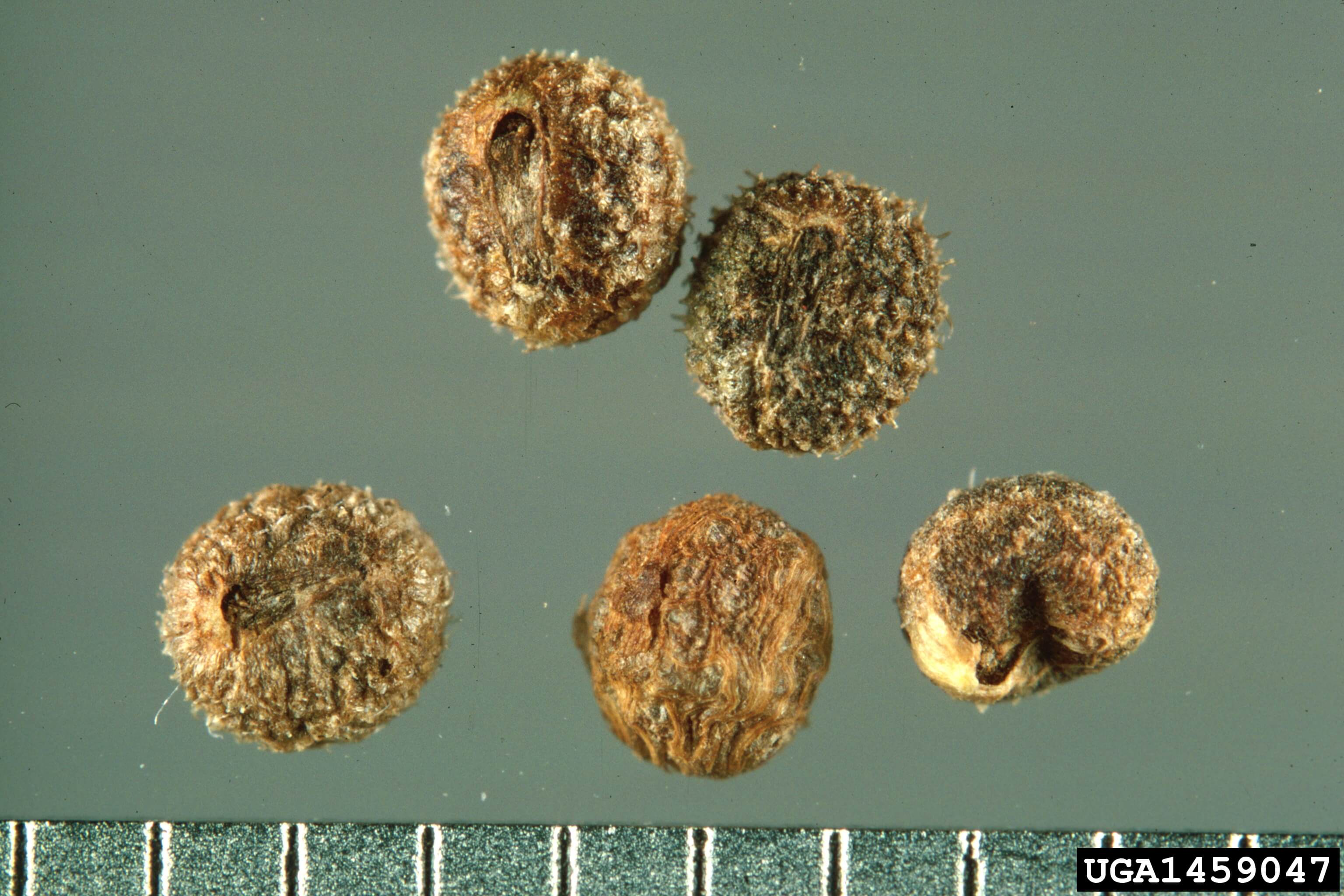 Figure 8. Cleavers seeds. Photo courtesy of Utah State University, Bugwood.org
Figure 8. Cleavers seeds. Photo courtesy of Utah State University, Bugwood.org
Reason for concern: Cleavers are the 6th most abundant weed in the Prairies and have been increasing in abundance in each of the last four weed surveys since 1973.1 Resistance to Group 2 (ALS inhibitors) has been identified in all the Prairie provinces. In Alberta, biotypes occur with multiple resistance to Group 2 and Group 4 (growth regulators) herbicides. In canola, cleaver seeds are considered contaminants of the grain.
Identification: Cleavers and false cleavers can grow as annual or winter annuals. They have a vine-type growth and may grow along the ground or around other plants (Figure 6). The stems are square with hooks that point downward and cling to surfaces. Cotyledons are oblong (Figure 7). The leaves grow in whorls of six to eight narrow, pointed leaves 2.5to 7.5 cm (1 to 3 inches) long. Flowers are minute and grow in axils of upper leaves. Fruits grow in pairs which cleave as they mature. Seeds are also bristly and small, similar in size to canola seeds (Figure 8). Seeds typically remain viable for 2 to 3 years in the soil and can remain viable even after passing through an animal’s digestive system. Seeds germinate in cool temperatures and in dark or low light.
Management: Integrated weed management includes crop rotation with competitive crops and vigorous cultivars. Limit seed spread by using certified seed and clean equipment. Control winter annual seedlings in the fall. Manage cleavers prior to crop emergence. Waiting for an in-crop herbicide application may be too late as winter annual types can grow quickly and become more difficult to control.
Common name: Kochia
Scientific name: Kochia scoparia
Life Cycle: Summer annual
 Figure 9. Kochia seedling.
Figure 9. Kochia seedling.
 Figure 10. Kochia plant.
Figure 10. Kochia plant.
 Figure 11. Lance-shaped kochia leaves covered with hairs. Photo courtesy of Steven Gower.
Figure 11. Lance-shaped kochia leaves covered with hairs. Photo courtesy of Steven Gower.
 Figure 12. Kochia flowers and fruit. Photo courtesy of Howard F. Schwartz, Colorado State University., Bugwood.org.
Figure 12. Kochia flowers and fruit. Photo courtesy of Howard F. Schwartz, Colorado State University., Bugwood.org.
Reason for concern: Multiple resistance to herbicide groups is increasing and limiting herbicide control options. Group 2 (ALS inhibitors) resistance is commonly found in kochia with the first reported cases in the Prairies in 1988. In 2012, the first cases of Group 9 (glyphosate) resistance were reported in Alberta and Saskatchewan and in 2014 in Manitoba. In each of these cases, Group 2 resistance was also present in the sample. Saskatchewan confirmed multiple resistance to Group 2 and Group 4 herbicides (growth regulators) in 2015. Alberta confirmed three-way herbicide resistance to Groups 2, 4, and 9 in 2017.1
Identification: Kochia is a troublesome weed across the Prairies. It can be found in crop fields, pastures, rangeland, roadsides, ditch banks, and wastelands. Kochia is competitive with crops and problematic in fallow periods between crops. Understanding the biology of kochia helps in developing management strategies for the weed.2
Kochia is one of the earliest summer annual broadleaf weeds to germinate in the spring, and it will continue to germinate throughout the growing season. Kochia reproduces only by seeds, which will generally survive 1 to 2 years in the soil. Kochia seeds germinate at shallow soil depths.3 Seedlings have thick, dull-green leaves, and the undersides of kochia cotyledons on seedlings are usually bright pink or magenta in colour. Young plants form a small rosette (Figure 9).4 Kochia is capable of germinating at colder soil temperatures and is quite tolerant of frost. Because kochia germinates early, it can be in advanced stages of growth when other weeds are ready to spray.
Kochia grows rapidly and can reach 2 metres (6 feet) in height when grown in competition with other plants. Without competition, it can grow to be a bushy plant, typically reaching heights of approximately one metre (3 to 4 feet). Kochia plants develop many branches with stems that are often red-tinged (Figure 10). Leaves are lance-shaped, pale green, and covered with hairs (Figure 11). Kochia flowers are inconspicuous, green, and in clusters up to 5 cm (2 inches) long (Figure 12). Clusters occur at the ends of stems and in leaf axils. Kochia flowers and sets seed in late summer and fall, with a single plant capable of producing up to 50,000 seeds that can be spread by wind, water, equipment, and as contaminants in hay.2 The seed is often dispersed after plants mature and become “tumbleweeds”, dropping seeds as they blow around.
Management: Kochia is tough to control because it is widely adapted, tolerates stress, emerges early with an extended germination period, has narrow leaves which are more difficult to cover with herbicide applications, and produces an abundance of seed that can spread over long distances. Kochia plants are tolerant of drought and saline soils and do well under growing conditions considered poor for most crops. Seeds germinate at shallow soil depths, making no-till a good environment for kochia survival. Kochia plants can self– or cross-pollinate, increasing the likelihood of resistant genes moving across populations.
Best management practices should be adopted for the containment and management of resistant weed populations.2 This includes integration of cultural and mechanical weed management practices, and the use of diversified and effective control tactics with herbicides.
Crop rotation has been shown to be an important factor for managing kochia. A multi-state university study has shown corn and soybean plants to compete well with kochia, suppressing growth and development.5 Corn and soybeans have more herbicide options for kochia management than other annual rotational crops. Wheat and fallow were less effective than corn or soybeans, and sugarbeets were found to be ineffective in suppressing kochia growth. Diverse crop rotations can include the use of multiple management tactics and herbicides with different sites of action for more effective control of kochia.
Using both preemergence (soil-residual) and postemergence herbicides with multiple sites of action is also an important management strategy to control kochia populations. Using multiple herbicide application timings (burndown, preplant, preemergence and postemergence, and postharvest) in-crop or fallow are the most effective means to control multiple flushes of kochia during the season. Kochia plants that escape herbicide applications should be controlled using tillage or physically removed before seed production.
Sources:
1 Heap, I. 2021. The international survey of herbicide resistant weeds. http://www.weedscience.org.
2 Jha, P., McVay, K., Varanasi, A., and Kumar, V. 2013. Glyphosate-resistant kochia in Montana - Herbicide recommendations and best management practices for growers. Montana State University Extension Research Bulletin No. 4602.
3 Schwinghamer, T.D. and Van Acker, R.C. 2008. Emergence timing and persistence of kochia. Weed Science. Vol. 56. Pp 37-41.
4 Kochia weed gallery. University of California IPM program. http://www.ipm.ucdavis.edu.
5 Sandell, L. 2012. Glyphosate-resistant kochia confirmed in Nebraska. UNL CropWatch. http://cropwatch.unl.edu.
Web links verified 4/22/2021
Common name: Green foxtail
Scientific name: Setaria viridis(L) Beauv.
Life Cycle: Annual
 Figure 13. Green foxtail leaves are hairless, rough, and up to 30 cm (12 inches) long. Sheaths are usually hairless except for short hairs along the margins. Picture courtesy of Bruce Ackley, The Ohio State University, Bugwood.org.
Figure 13. Green foxtail leaves are hairless, rough, and up to 30 cm (12 inches) long. Sheaths are usually hairless except for short hairs along the margins. Picture courtesy of Bruce Ackley, The Ohio State University, Bugwood.org.
 Figure 14. Green foxtail seedhead. Photo courtesy of Howard F. Schwartz, Colorado State University, Bugwood.org.
Figure 14. Green foxtail seedhead. Photo courtesy of Howard F. Schwartz, Colorado State University, Bugwood.org.
Reason for concern: Green foxtail has been ranked number one for relative abundance in the Prairies in each of the last five weed surveys since 1973.1 Green foxtail has developed resistance to Group 1 (ACCase inhibitors) and Group 3 (microtubule assembly inhibitors) sites of action across all Prairie provinces and Group 2 (ALS inhibitors) in Saskatchewan and Manitoba. Additionally, green foxtail can be found with resistance to both Group 1 and Group 3 herbicides in Saskatchewan and Manitoba.2
Identification: Green foxtail has a round stem, hairy ligule, and no auricle. There are short hairs along the leaf margin near the sheath (Figure 13). The seed head is fuzzy and green (Figure 14). Green foxtail has no auricle. Short hairs can be found on the leaf margin near the sheath.3 Green foxtail begins germinating with warm temperatures in the spring. It can emerge in flushes following rain events throughout the growing season.
Management: Using cultural practices along with chemical control diversifies management and reduces the risk of developing herbicide resistance. To manage green foxtail, start with burndown herbicides with residual benefits where possible. Apply postemergence herbicides early when plants are young and 10 cm (4 inches) in height or less. Use multiple sites of action for both pre- and postemergence herbicide applications to help manage resistance development.
Similar species: Green foxtail (Setaria viridis) and yellow foxtail (Setaria pumila) can be difficult to distinguish from each other. Both are summer annuals and form the distinctive, fuzzy, foxtail seed head. Both grow upright and have a ligule that is a fringe of hairs. Green foxtail has a smooth upper leaf surface (Figure 13), while yellow foxtail has a smooth upper leaf except for prominent, scattered, long hairs near the collar (Figure 15). Yellow foxtail has flat leaf sheaths with a reddish-purple tint at the base. Green foxtail has round leaf sheaths. The leaf sheath of green foxtail is lined with small hairs.
One of the most distinguishing features is the colour of the seed head. Green foxtail seed heads are green or purple tinted (Figure 14). Yellow foxtail seed heads turn yellowish brown at maturity and are more compact compared to green foxtail (Figure 16).3
 Figure 15. Yellow foxtail leaves are hairless except for long, wispy hairs on the upper leaf surface near the collar. Photo courtesy of Steven Gower.
Figure 15. Yellow foxtail leaves are hairless except for long, wispy hairs on the upper leaf surface near the collar. Photo courtesy of Steven Gower.
 Figure 16. Yellow foxtail seedhead. Photo courtesy of Steven Gower.
Figure 16. Yellow foxtail seedhead. Photo courtesy of Steven Gower.
Sources:
1 Leeson, J. Y., Gaultier, J., Hall, L., Neeser, C. Residual weed population shifts in the Prairie Provinces – 1973 to 2017. Agriculture and Agri-Food Canada.
2 Manitoba Agriculture and Resource Development. Guide to field crop protection 2020. Prepared by Manitoba Agriculture and Resource Development in co-operation with Saskatchewan Agriculture.
3 Bradly, K. 2014. Weed of the month: the foxtails, similar yet different. Integrated Pest Management. University of Missouri. http://ipm.missouri.edu.
Web links verified 4/22/2021
Common name: Wild buckwheat
Scientific name: Polygonum convolvulus
Life Cycle: Summer annuall
 Figure 17. Black, three-sided seeds of wild buckwheat. Photo courtesy of Bruce Ackley, The Ohio State University, Bugwood.org
Figure 17. Black, three-sided seeds of wild buckwheat. Photo courtesy of Bruce Ackley, The Ohio State University, Bugwood.org
 Figure 18. Wild buckwheat seedling. Photo courtesy of Bruce Ackley, The Ohio State University, Bugwood.org
Figure 18. Wild buckwheat seedling. Photo courtesy of Bruce Ackley, The Ohio State University, Bugwood.org
 Figure 19. Wild buckwheat plant. Photo courtesy of Bruce Ackley, The Ohio State University, Bugwood.org.
Figure 19. Wild buckwheat plant. Photo courtesy of Bruce Ackley, The Ohio State University, Bugwood.org.
Reason for concern: Wild buckwheat is a major weed problem in the Prairies, regularly ranking in the top three species of Provincial weed surveys.1
Identification: Wild buckwheat is a summer annual that grows from a hard, black, triangular seed about 3 mm (1/8-inch) long (Figure 17). The cotyledons are narrow with a rounded tip and base (Figure 18). The plant has long, slender, creeping stems that trail along the ground or climb any plants or objects they contact. The leaves are alternate, heart- or arrowhead-shaped, pointed at the tip, and have widely-separated lobes at the base (Figure 19). Plants bloom throughout the summer and the flowers are small and have no petals but have 5 greenish or pinkish sepals. Flowers are in short-stemmed clusters in the axils of the leaves or at the end of stems. Wild buckwheat is a member of the smartweed family. Like other smartweeds, wild buckwheat possesses an ocrea around the stem at each node. It can be confused with field bindweed because of its vining growth habit and arrowhead-shaped leaves. Field bindweed, however, is a perennial, has an extensive underground root system, does not possess an ocrea, and has large, funnel-shaped flowers that are white or pink. Also, wild buckwheat’s lower leaves are usually much wider than bindweed leaves.
Wild buckwheat begins germinating very early in the spring during the first prolonged warm period. Most of wild buckwheat seed emergence occurs by mid-June. Wild buckwheat’s climbing habit allows the plant to obtain sunlight while growing in stands of grain or other tall crops. It also can spread horizontally and quickly cover bare ground, enabling it to maximize light-gathering efficiency.
Watchout: In addition to competing for nutrients, light, and moisture, wild buckwheat causes difficulty in harvesting crops.
Management: Cultural practices, such as crop rotation, mowing, delayed seeding, post-seeding harrowing, or postharvest cultivating, can help reduce wild buckwheat stands, but have not been effective in control. Delayed crop seeding can help manage wild buckwheat by killing early germinating seedlings through seedbed preparation or burndown herbicide applications.
Wild buckwheat and related smartweed species have some natural tolerance to glyphosate. Wild buckwheat control from glyphosate is reduced when applications are made at lower than labeled rates, when only one glyphosate application is made, when plants are stressed from adverse environmental conditions, or when runners are more than 7 to 10 cm (3 to 4 inches) long. The most effective herbicides on wild buckwheat are atrazine, bromoxynil, clopyralid, dicamba, glufosinate, and some sulfonylurea products. Using these herbicides or mixtures with these ingredients will ensure the most effective wild buckwheat control. Atrazine, clopyralid, dicamba, and some sulfonylurea herbicides may persist in the soil and carry over for more than one growing season, especially in soils with high pH.
All existing weeds (including wild buckwheat) should be controlled prior to planting or emergence of no-till crops with a preplant burndown herbicide treatment. Glyphosate or glyphosate plus 2,4-D is often inadequate for wild buckwheat control. Adding or using another herbicide may be necessary to achieve adequate wild buckwheat control, but proper waiting intervals between applications must be observed. Crops planted before early or mid-May could require an in-crop herbicide application to control late-emerging plants. This strategy will allow earlier postemergence applications to smaller plants.
Sources:
1Leeson, J. Y., Gaultier, J., Hall, L., Neeser, C. Residual weed population shifts in the Prairie Provinces – 1973 to 2017. Agriculture and Agri-Food Canada.
Wild buckwheat. UC IPM. University of California Agriculture and Natural Resources. http://ipm.ucanr.edu
Zollinger, R., Peterson, D., and Moechning, M. 2006. Biology and management of wild buckwheat. GWC-10. Purdue Extension. http://extension.purdue.edu
Web links verified 4/22/2021
Common name: Volunteer canola
Scientific name: Brassica napus
Life Cycle: Summer annual
 Figure 20. Seedling canola.
Figure 20. Seedling canola.
 Figure 21. Canola rosette. “Cabbaging.”
Figure 21. Canola rosette. “Cabbaging.”
.ashx?sc_lang=en&hash=ECFC76464051A404685C175FC4150E2C) Figure 22. Canola inflorescence.
Figure 22. Canola inflorescence.
Reason for concern: Volunteer canola is ranked in the top five for weeds in the Prairies based on relative abundance.1 This ranking has increased from 14th in 2003.1 Harvest losses of canola seed results in an average of 73 kg per hectare (1.3 bushels per acre) of canola seed left in the field.2 Canola can be bred with tolerance to Group 2 (ALS inhibitors), Group 9 (glyphosate), and Group 10 (glufosinate) herbicides. Volunteer canola can host diseases for future canola crops such as blackleg and clubroot and should be controlled.
Identification: Canola is an annual crop grown across the Prairies. Volunteer canola can emerge early in the spring and throughout the year. Germination begins at soil temperatures as low as 1 to 2oC.3 Cotyledons are heart-shaped (Figure 20). The stalks are hairless, and few hairs are found on underside of leaves. The true leaves emerge one at a time and opposite to each other forming a basal rosette (Figure 21). The stalk elongates and small, yellow, four-petaled flowers emerge indeterminately (Figure 22). Additional branches can also emerge and flower. Pods are long and narrow and fill with small, spherical, dark coloured seed.
Management: Following canola harvest, leave seeds on the soil surface to allow them to germinate in fall to be winter-killed or eaten. Tillage can incorporate canola seeds and induce secondary dormancy lasting up to four years. In the spring, allow volunteer canola emergence before tilling or spraying. Expect to manage volunteer canola in rotational crops where there are herbicide options. When small, canola is easier to manage with herbicide. In the year of canola, burn-down herbicides should include an additional siteof action for canola control to help reduce populations of early emerged volunteer canola.4 Watch the label for re-cropping restrictions to ensure that the canola crop won’t be harmed. Additional integrated weed management includes increasing crop competition by cultivar selection, narrower row spacing, increasing seeding rate, and lengthening crop rotation between canola crops.
Similar species: Wild mustard can be mistaken for canola. At the cotyledon stage, it is nearly impossible to differentiate between the plants; however, once the first true leaf emerges differences can be noticed. Canola leaves are blue-green with wavy margins while mustard leaves are yellow-green with coarsely toothed margins (Figures 23 and 24). In the rosette stage, mustard leaves have petioles while canola leaves grow up to the stem and may clasp partially around it. Wild mustard stems have white hairs that point downward, and purple rings can be found at the base of young stems. Mustard flowers are yellow with 4 petals growing in terminal clusters (Figure 25). Fruit of wild mustard are cylinder-shaped capsules about 2.5 cm (one inch) long with a beak at the tip.
 Figure 23. Wild mustard cotyledon with first leaf emerging.
Figure 24. Wild mustard leaf (left) canola leaf (right).
Figure 23. Wild mustard cotyledon with first leaf emerging.
Figure 24. Wild mustard leaf (left) canola leaf (right).
 Figure 25. Wild mustard plant with flowering shoots.
Figure 25. Wild mustard plant with flowering shoots.
Common name: Lamb’s-quarters
Scientific name: Chenopodium album
Life Cycle: Summer annual
 Figure 26. Lamb’s-quarters seedling. Photo courtesy of Steven Gower.
Figure 26. Lamb’s-quarters seedling. Photo courtesy of Steven Gower.
 Figure 27. Lamb’s-quarters plant. Photo courtesy of Steven Gower.
Figure 27. Lamb’s-quarters plant. Photo courtesy of Steven Gower.
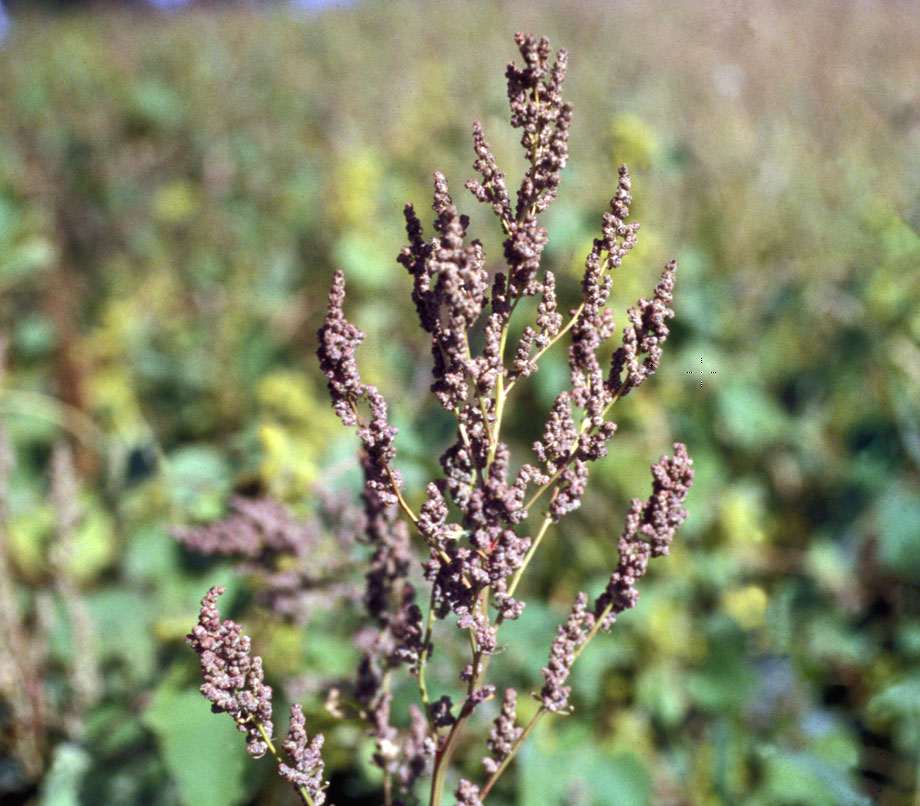 Figure 28. Lamb’s-quarters seed head. Photo courtesy of Steven Gower.
Figure 28. Lamb’s-quarters seed head. Photo courtesy of Steven Gower.
Reason for concern: Lamb’s-quarters is prevalent across the Prairies, consistently ranking 5th in relative abundance.1
Identification: Lamb’s-quarters is an annual weed belonging to the goosefoot family and is common across the Prairies. Like many small-seeded annuals, lamb’s-quarters germinates at or near the soil surface with the optimum seed depth for emergence being about 2.5 mm (1/10 of an inch). Initially, leaves appear opposite in arrangement, later becoming alternate, and may be purplish on the underside with both surfaces covered with white granules or a mealy substance (Figure 26). More mature plants have broad, triangle-shaped leaves with irregular, shallow-toothed margins (Figure 27). The stems are vertically grooved with green or reddish stripes, and hairless. Mature plants generally reach a height of 0.6 to 1.8 m (2 to 6 feet). An average lamb’s-quarters plant can produce more than 70,000 seeds (Figure 28). Lamb’s-quarters seed is one of the most persistent in the soil seedbank. On average, it takes 12 years to reduce lamb’s-quarters seed in the soil seedbank by 50% and 78 years to deplete the seedbank by 99%.2
Management: The most effective herbicide programs to control lamb’s-quarters combine preemergence and postemergence herbicide treatments and two or more herbicide sites of action, especially in soybean. For example, effective lamb’s-quarters management programs include:
- Control of emerged weeds prior to planting with tillage or a pre-plant burndown herbicide application.
- Applying preemergence herbicides with activity on lamb’s-quarters.
- Applying postemergence herbicides before lamb’s-quarters exceed the recommended plant height for control, usually 10 to 15 cm (4 to 6 inches).
- Controlling escapes or plants that emerge after the initial postemergence application with a second postemergence application. Lamb’s-quarters is similar to common ragweed in that it is much easier to control in corn and small grain crops than in soybean.
Sources:
1 Leeson, J. Y., Gaultier, J., Hall, L., Neeser, C. Residual weed population shifts in the Prairie Provinces – 1973 to 2017. Agriculture and Agri-Food Canada.
2 Curran, W. 2017. Management of triazine-resistant pigweed and lambsquarters: an integrated approach. Agronomy Facts 10. Penn State Extension. http://extension.psu.edu
Web links verified 4/22/2021
Common name: Canada thistle
Scientific name: Cirsium arvense
Life Cycle: Perennial
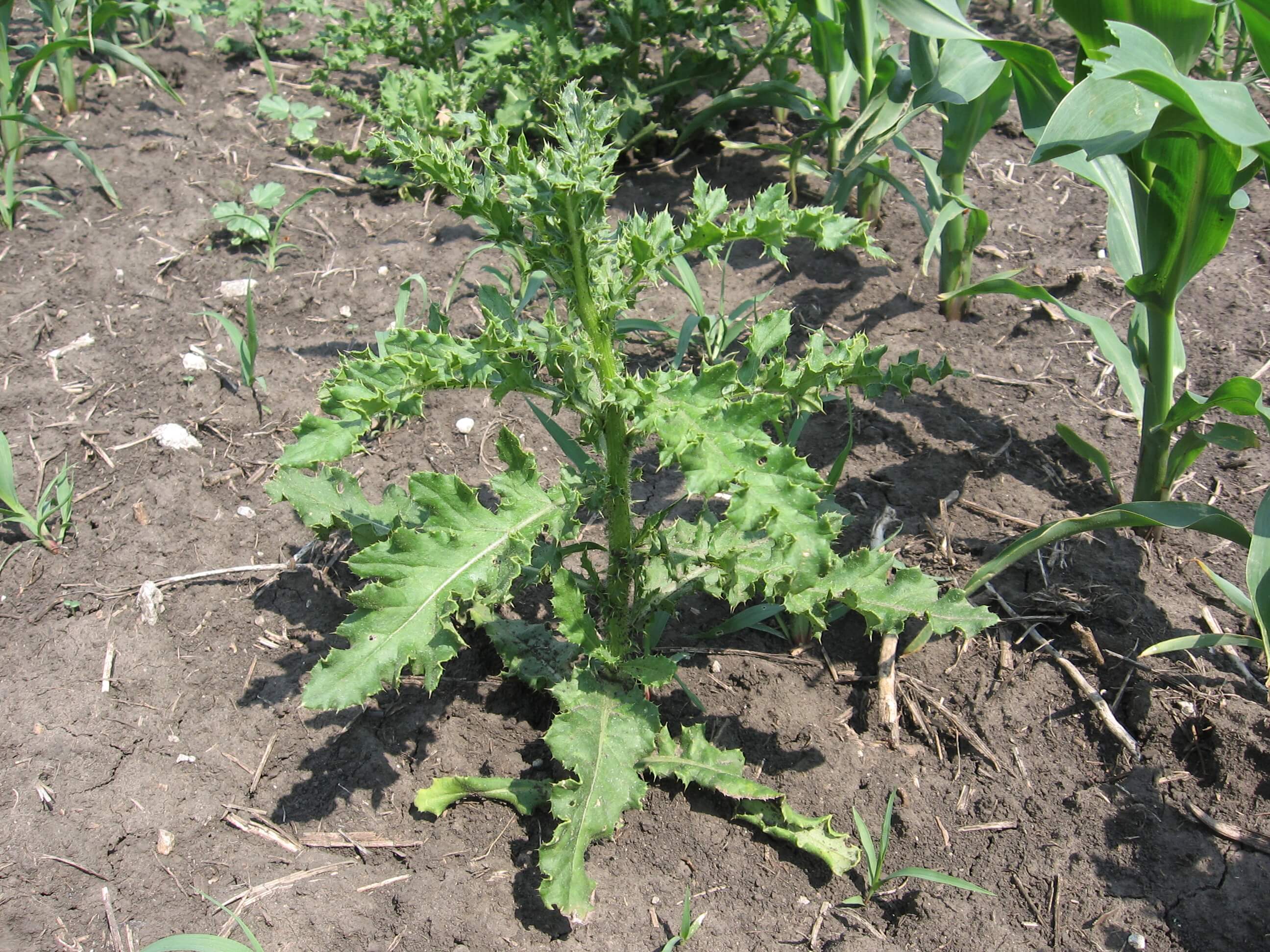 Figure 29. Canada thistle plant.
Figure 29. Canada thistle plant.
 Figure 30. Leaves of Canada thistle are oblong with irregular lobes and spiny margins. Photo courtesy of Ohio State Weed Lab, The Ohio State University, Bugwood.org.
Figure 30. Leaves of Canada thistle are oblong with irregular lobes and spiny margins. Photo courtesy of Ohio State Weed Lab, The Ohio State University, Bugwood.org.
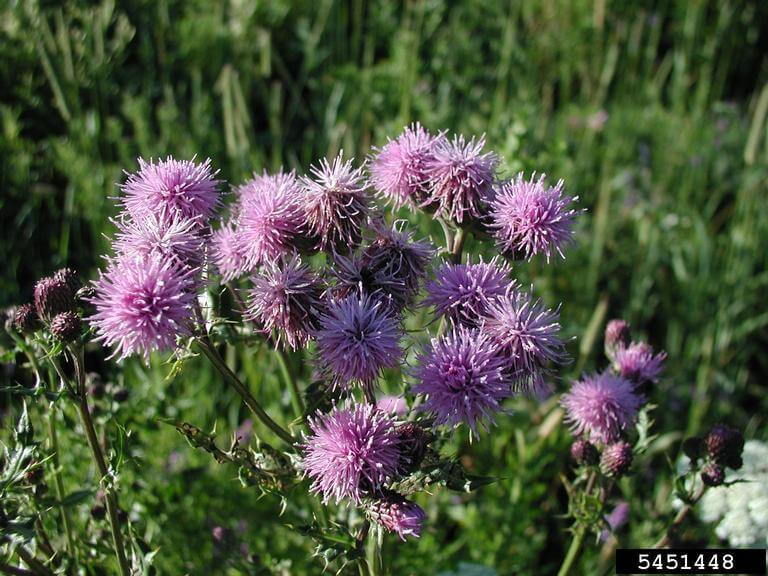 Figure 31. Canada thistle flower head. Photo courtesy of Leslie J. Mehrhoff, University of Connecticut, Bugwood.org
Figure 31. Canada thistle flower head. Photo courtesy of Leslie J. Mehrhoff, University of Connecticut, Bugwood.org
Reason for concern: Canada thistle ranks 7th for relative abundance in the most recent weed survey and has been in the top 10 since 1981.1 Where Canada thistle is found it can be difficult to manage due to its ability to regrow and spread from creeping roots.
Identification: Canada thistle is an aggressive perennial that reproduces vegetatively from creeping roots and from seed. Creeping roots provide stored food and numerous underground buds to depths well below the plow layer. Canada thistle plants can grow 0.6 to 1.5 m (2 to 5 feet) tall and branch at the top (Figure 29). Leaves are alternate, sessile, simple, and oblong with irregular lobes and spiny margins (Figure 30). Stems are grooved, hollow, and become hairy with age. Male and female flowers occur on separate plants (dioecious) and seed production requires the presence of both plants. Flower heads are about 19 mm (3/4 inch) wide and consist of purple or pink disk flowers surrounded by spineless bracts (Figure 31). Fruit are flat, brown, 4.2 mm (1/6 inch) long achenes with tufts of hair.
Similar Species: Plants most likely to be confused with Canada thistle are other thistles. Canada thistle can be differentiated from bull thistle (Cirsium vulgare) (Figure 32) and nodding thistle (Carduus nutans) (Figure 33) by its spineless stems and flowers without spines or prickles, both of which are present on these other two thistle species. Additionally, Canada thistle plants grow in distinct patches due to the rhizome root growth (Figure 34).
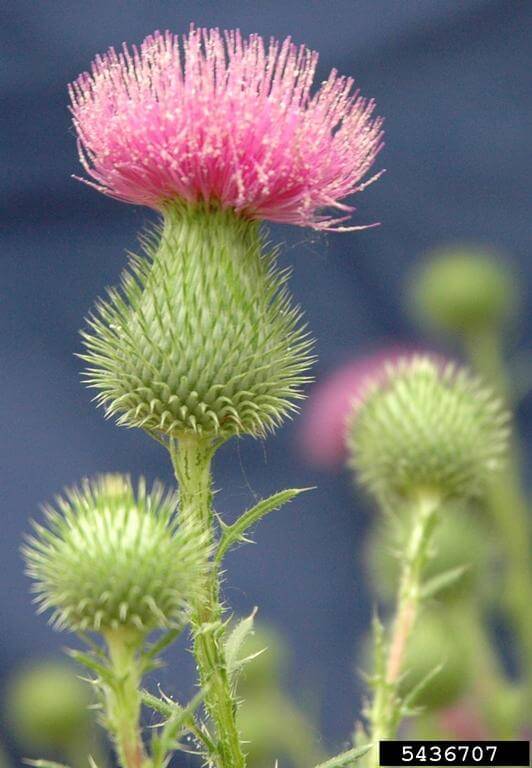 Figure 32. Bull thistle flower head. Photo courtesy of Bruce Ackley, The Ohio State University, Bugwood.org.
Figure 32. Bull thistle flower head. Photo courtesy of Bruce Ackley, The Ohio State University, Bugwood.org.
 Figure 33. Nodding thistle flower head. Photo courtesy of Eric Coombs, Oregon Department of Agriculture, Bugwood.org.
Figure 33. Nodding thistle flower head. Photo courtesy of Eric Coombs, Oregon Department of Agriculture, Bugwood.org.
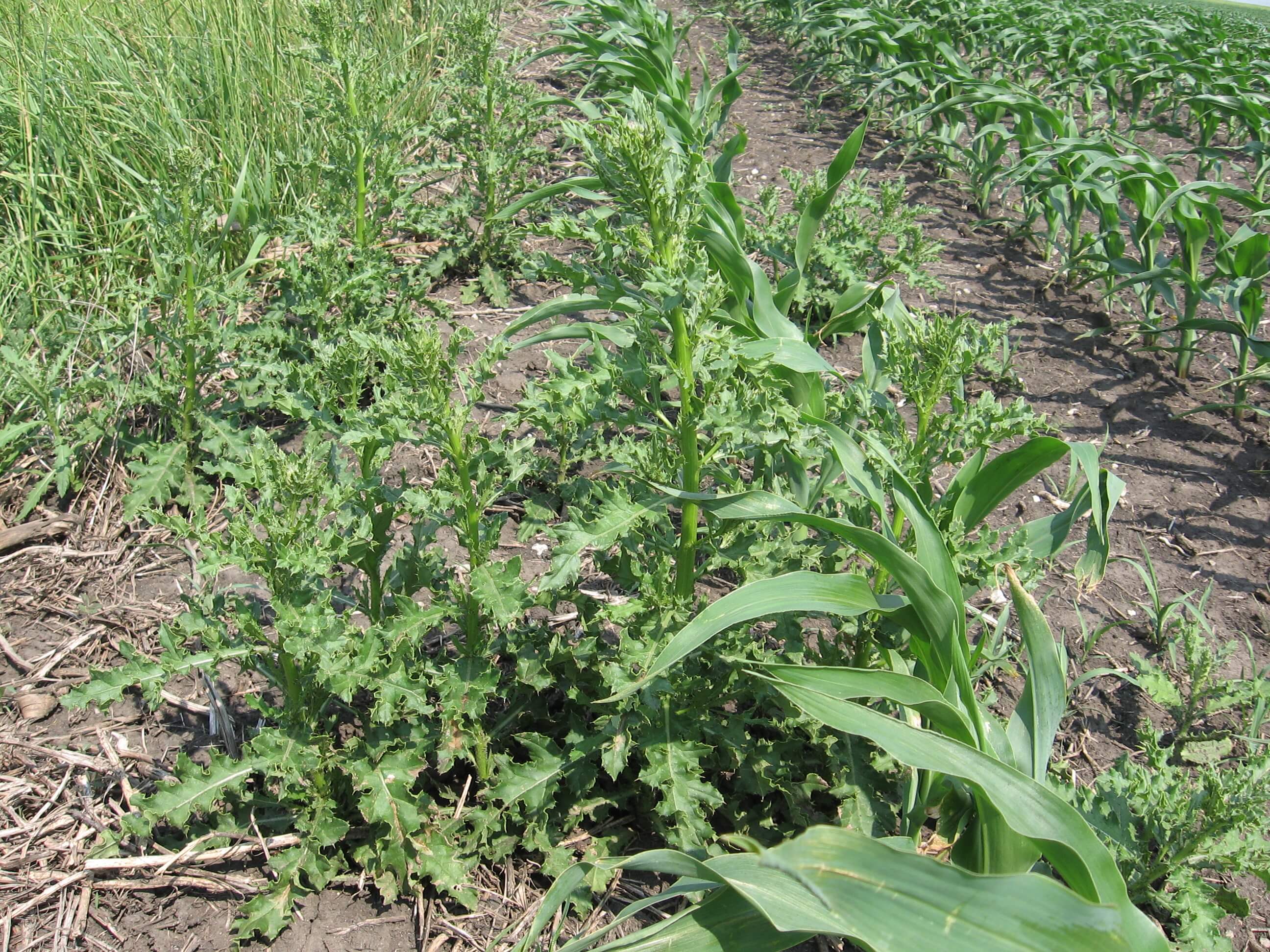 Figure 34. Distinct patch of Canada thistle due to rhizome root growth.
Figure 34. Distinct patch of Canada thistle due to rhizome root growth.
Management: Canada thistle is difficult to manage, and control is best achieved through an integrated program. Tillage can increase the problem by spreading vegetative roots of Canada thistle, which can also be moved from field to field on tillage equipment. Including forages or small grains in the rotation can help manage Canada thistle. Canada thistle is susceptible to shading. Conditions that favour rapid crop canopy closure (good stand establishment, fertility, narrow row spacings) compliment other control practices.
Canada thistle is most susceptible to systemic herbicides and is best controlled between the bud and flower stages. However, most herbicides have a maximum crop height or stage restriction for application; refer to the herbicide label for these restrictions.
Biological Control Agents: Various insects as well as fungal and bacterial pathogens can attack Canada thistle. Typically, biological controls alone will not control Canada thistle and need to be combined with other methods to be successful.
Sources:
1 Leeson, J. Y., Gaultier, J., Hall, L., Neeser, C. Residual weed population shifts in the Prairie Provinces – 1973 to 2017. Agriculture and Agri-Food Canada.
Beck, K.G. 2013. Canada thistle. Fact Sheet 3.108. Colorado State University Extension. http://extension.colostate.edu
Ross, M. Control practices for Canada thistle. Department of Botany and Plant Pathology. Purdue University. http://btny.purdue.edu.
Web links verified 4/22/2021
Common name: Spiny Annual Sow thistle
Scientific name: Sonchus asper
Life Cycle: Annual/Winter annual
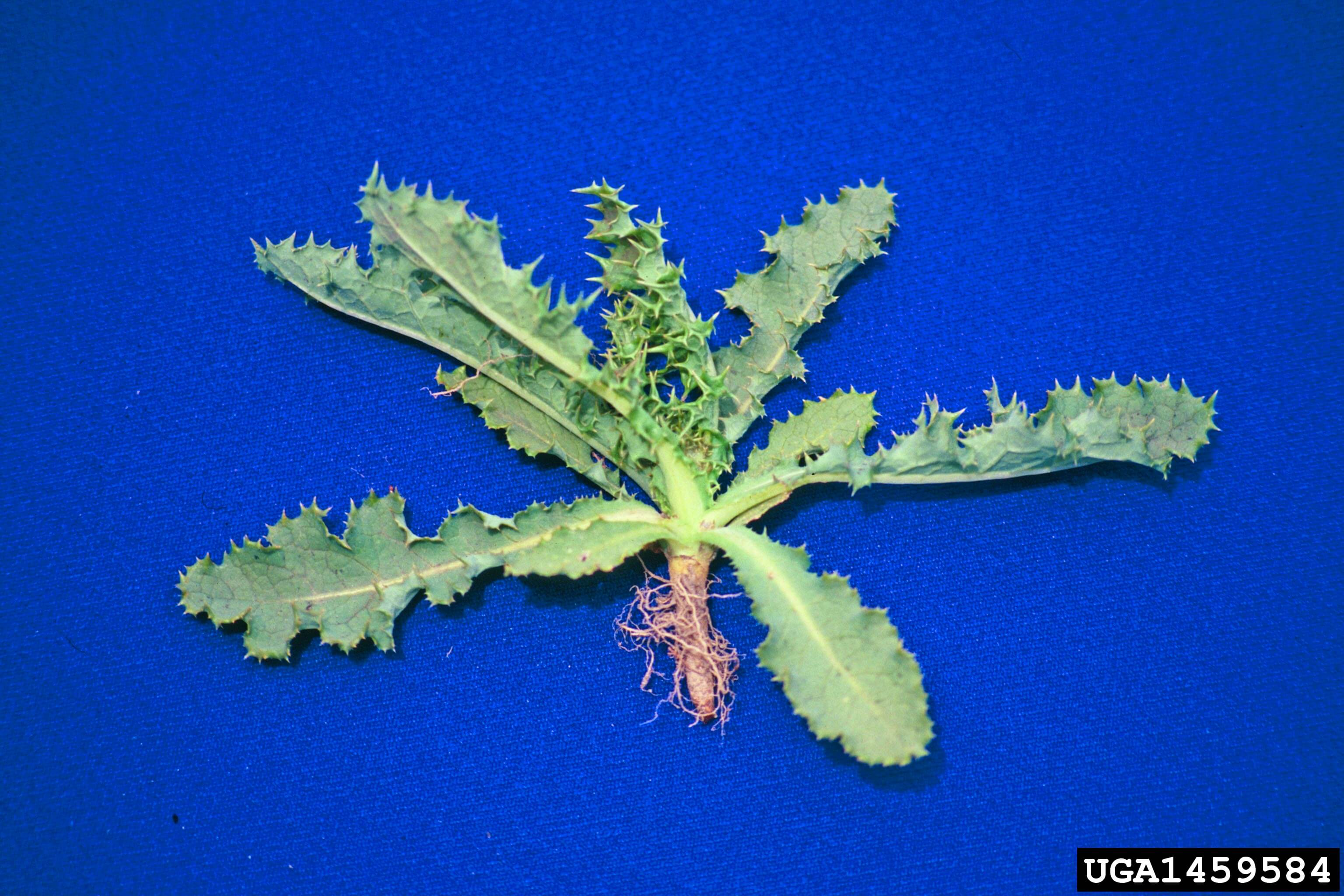 Figure 35. Spiny annual sow thistle rosette and tap root. Steve Dewey, Utah State University, Bugwood.org
Figure 35. Spiny annual sow thistle rosette and tap root. Steve Dewey, Utah State University, Bugwood.org
 Figure 36. Spiny annual sow thistle leaves with rounded lobes at stem. Bruce Ackley, The Ohio State University, Bugwood.org
Figure 36. Spiny annual sow thistle leaves with rounded lobes at stem. Bruce Ackley, The Ohio State University, Bugwood.org
 Figure 37. Spiny annual sow thistle flower. Bruce Ackley, The Ohio State University, Bugwood.org
Figure 37. Spiny annual sow thistle flower. Bruce Ackley, The Ohio State University, Bugwood.org
Reason for concern: Spiny annual sow thistle is becoming a greater concern in the Prairies. It has increased in relative abundance from 138th in 1981 to 8th in 2017.1 This is a difficult weed to control with in-crop herbicides. Where Group 2 (ALS inhibitors) herbicide resistance is present, control options are further limited for this weed.
Identification: Spiny annual sow thistle is in the Asteraceae family along with perennial sow thistle, annual sow thistle, Canada thistle, dandelion, and other similar plants. Sow thistles can be distinguished from other thistles by the milky sap exuded when the plant is broken. Cotyledons are oval. Leaves are toothed with spiny margins forming a basal rosette before the stem elongates Figure 35). Upper leaves have distinctive rounded lobes at the stem (Figure 36). The milky sap emitted when a plant is broken, occurs at all plant parts by the fourth-leaf stage. Stems are hairless. Flowers are dandelion-like, a yellow ray 1.5 to 2.5 cm (0.5 to 1 inch) in diameter (Figure 37). Seeds are flat, brown, and ribbed with tufts of hair which form a puff ball on the plant.
Similar species: Annual sow thistle and perennial sow thistle are similar to spiny annual sow thistle. Annual sow thistle can be identified by the leaves which are deeply lobed (Figure 38). The upper leaves have distinctive pointed lobes at the stem (Figure 39). Annual sow thistle is not as prickly as spiny annual sow thistle. Perennial sow thistle can be distinguished by its creeping roots. It also has yellow-orange hairs on the stem below the flower and larger flowers than spiny annual sow thistle.
 Figure 38. Annual sow thistle with deeply lobed leaves. Forest and Kim Starr, Starr Environmental, Bugwood.org
Figure 38. Annual sow thistle with deeply lobed leaves. Forest and Kim Starr, Starr Environmental, Bugwood.org
 Figure 39. Annual sow thistle leaves with pointed lobes at the stem. Chris Evans, University of Illinois, Bugwood.org
Figure 39. Annual sow thistle leaves with pointed lobes at the stem. Chris Evans, University of Illinois, Bugwood.org
Management: Group 2 resistance occurs in some spiny annual sow thistle populations in Alberta and Manitoba.2 Group 4 (growth regulators), Group 6 (Photosystem II inhibitors), Group 9 (glyphosate), Group 10 (glufosinate), and Group 22 (Photosystem I inhibitors) herbicides may help to control infestations of spiny annual sow thistle. Be sure to read and follow the herbicide labels. Removing patches of plants prior to seed set may be an option where patches are small. Removal of the entire taproot is required for this management option. Grazing can also help suppress infestations.3
Sources:
1 Leeson, J. Y., Gaultier, J., Hall, L., Neeser, C. Residual weed population shifts in the Prairie Provinces – 1973 to 2017. Agriculture and Agri-Food Canada.
2 Manitoba Agriculture and Resource Development. Guide to field crop protection 2020. Prepared by Manitoba Agriculture and Resource Development in co-operation with Saskatchewan Agriculture.
3 CAB International. 2018. Sonchus asper (spiny sow-thistle) datasheet in Invasive Species Compendium. https://www.cabi.org/isc/datasheet/110319#tosummaryOfInvasiveness
Bubar, C. J., McColl S. J., Hall, L. M. 2000. Weeds of the Prairies. Alberta Agriculture and Rural Development. University of Missouri. Weed ID Guide. https://weedid.missouri.edu/
Web sources verified 4/22/2021
Common name: Dandelion
Scientific name: Taraxacum officinale
Life Cycle: Perennial
 Figure 40. Dandelion seedlings. Photo courtesy of Bruce Ackley, The Ohio State University, Bugwood.org.
Figure 40. Dandelion seedlings. Photo courtesy of Bruce Ackley, The Ohio State University, Bugwood.org.
 Figure 41. Young dandelion rosette. Photo courtesy of Bruce Ackley, The Ohio State University, Bugwood.org.
Figure 41. Young dandelion rosette. Photo courtesy of Bruce Ackley, The Ohio State University, Bugwood.org.
 Figure 42. Mature, flowering dandelion in no-till.
Figure 42. Mature, flowering dandelion in no-till.
 Figure 43. Dandelion seed head. Photo courtesy of Joseph Berger, Bugwood.org.
Figure 43. Dandelion seed head. Photo courtesy of Joseph Berger, Bugwood.org.
Reason for concern: Dandelion is ranked 9th for relative abundance; an increase from 31st in 1989.1 Their perennial growth habit makes dandelions difficult to control in-crop. Herbicide options are limited for in-crop application and herbicides that may control dandelions can have re-cropping restrictions limiting crop options in future years.
Identification: Dandelion is a simple perennial that forms a basal rosette with yellow flowers and a puff-ball seed head. Dandelion is one of the most common and problematic weeds of turfgrass and lawns and can also be problematic in no-till crop production. Plants emerge from seed and the root becomes a perennial taproot system that persists over the winter. Dandelion captures space in forage crops and in no-till systems. It is not competitive for light but captures soil moisture and nutrients.
Cotyledons are light-green, smooth, and oval to spatulate in shape (Figure 40). Young leaves form a basal rosette and are also oval to spatulate in shape, 5 to 15 cm (2 to 6 inches) in length (Figure 41). Leaf margins are noticeably wavy, especially on older leaves. All leaves are basal, ranging from 5 to 40 cm (2 to 16 inches) in length depending on the environment. Usually, leaves are more in the range of 5 to 20 cm (2 to 8 inches) in length. Leaves are oblong in outline, sometimes sparsely hairy, deeply indented, with lobes that point toward the center of the rosette. Stems are erect, hollow, and approximately 5 to 15 cm (2 to 6 inches) in height giving rise to solitary, bright-yellow flowers (Figure 42). Fruit are an achene that is brown, 3 to 5 mm (0.1 to 0.2 inches) long, with a feathery pappus attached that aids in wind dispersal of seed (Figure 43). Collectively, the achenes form a white seed head that resembles a puff-ball.
Management: Regular soil disturbance is effective at preventing the establishment of dandelion plants; therefore, dandelions are seldom a problem in tilled cropping systems. Tillage must be deep enough to cut the root 10 cm (4 inches) below the crown. Both rotary hoeing and cultivation control seedling dandelions but have little effect on those that are established.
Herbicide options are available to suppress dandelion in corn, soybean, and alfalfa with control available in cereals and some canola traits. Spring applications of some herbicides control seedling dandelion. For perennial weeds, fall applications of herbicides are usually more effective than spring applications. Dandelion is one of the more difficult weeds to control. Differences in response of dandelion populations to 2,4-D ester and glyphosate have been observed. Where crops have emerged and dandelion are established, the strategy should be suppression to minimize yield loss from dandelion competition. In-season applications will substantially reduce dandelion competition but will likely not greatly reduce dandelion populations. Then a fall herbicide application can be planned following harvest with the goal of dandelion removal.
Sources:
1 Leeson, J. Y., Gaultier, J., Hall, L., Neeser, C. Residual weed population shifts in the Prairie Provinces – 1973 to 2017. Agriculture and Agri-Food Canada.
Kells, J., Hillger, D., and Sprague, C. May 4, 2006. Dandelion management in field and forage crops. Department of Crop and Soil Sciences. Michigan State University. http://canr.msu.edu
Web sources verified 4/22/2021
Common name: Narrow-leaved hawk’s-beard
Scientific name: Crepis tectorum
Life Cycle: Annual/Winter annual
.ashx?sc_lang=en&hash=0908AAAB4CEE255133A4F0A6638979F4) Figure 44. Narrow-leaved hawk’s-beard winter annual rosette. Photo courtesy of Danielle Tichit, Assiniboine Community College.
Figure 44. Narrow-leaved hawk’s-beard winter annual rosette. Photo courtesy of Danielle Tichit, Assiniboine Community College.
 Figure 45. Narrow-leaved hawk’s-beard winter annual rosettes with varying leaf lobing. Photo courtesy of Danielle Tichit, Assiniboine Community College.
Figure 45. Narrow-leaved hawk’s-beard winter annual rosettes with varying leaf lobing. Photo courtesy of Danielle Tichit, Assiniboine Community College.
 Figure 46. Stem leaves of narrow-leaved hawk’s-beard are narrow and directly attached to the stem. Photo courtesy of Danielle Tichit, Assiniboine Community College.
Figure 46. Stem leaves of narrow-leaved hawk’s-beard are narrow and directly attached to the stem. Photo courtesy of Danielle Tichit, Assiniboine Community College.
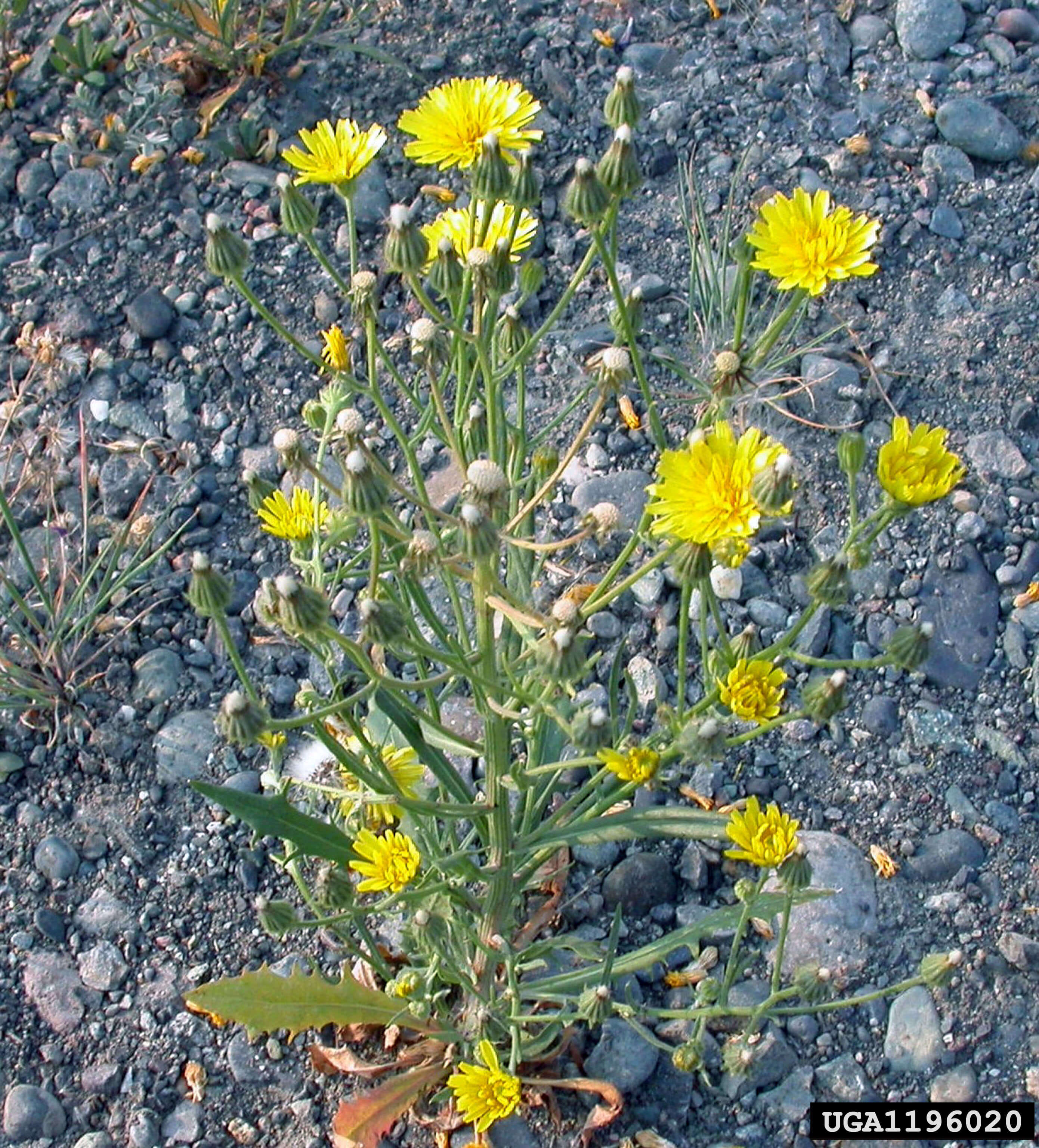 Figure 47. Flowering and branching on narrow-leaved hawk’s-beard plant. Michael Shephard, USDA Forest Service, Bugwood.org.
Figure 47. Flowering and branching on narrow-leaved hawk’s-beard plant. Michael Shephard, USDA Forest Service, Bugwood.org.
Reason for concern: Narrow-leaved hawk’s-beard has become more prominent recently, moving up from 24th in the early 2000’s to 11th in terms of relative abundance across the Prairies in the weed surveys conducted from 2008 to 2017.1 The winter annual growth habit of this weed makes it difficult to control in-crop.
Identification: Narrow-leaved hawk’s-beard can germinate in spring or fall. Leaves are narrow, irregularly toothed and can reach 15 cm (6 inches) in the basal rosette (Figures 44 and 45). In the seedling to rosette stage this weed may be confused with dandelion though dandelion leaves are darker in colour.2 Fall germinated seedlings form a rosette in fall and bolt quickly in the spring, making them competitive with crops. The stem leaves are narrow and directly attached to the stem with no petiole (Figure 46).3 A milky sap is produced when the stem is broken. The plant can grow approximately one metre tall with flower clusters extending from branches (Figure 47).4 Narrow-leaved hawk’s-beard reproduces by seed and has a deep taproot. The 2 cm (3/4 inch) wide dandelion-like yellow flower can emerge by mid-June forming a puff ball seed head.
Management:
This weed is more of a problem in forage crops and in fields under reduced-tillage where it can continue its life-cycle undisrupted. Use integrated weed management strategies to help manage this weed. Herbicide applications can be effective in spring or fall prior to the bolting growth stage as after bolting, control with herbicides becomes much more difficult. Bolting can happen early in spring and in-crop may be too late for effective weed control. Scout early in the spring and if overwintering rosettes are present, a burndown may be the best option to control these plants. Determine the narrow-leaved hawk’s-beard growth stage and plan the herbicide rate accordingly. Rosettes should be controlled when they are 15 cm (6 inches) in diameter or smaller.2 Seeding a competitive crop and seeding early can also be strategies to help manage this weed. Seedlings emerging through the growing season may be controlled with an in-crop herbicide application. Group 4 (growth regulators) and Group 9 (glyphosate) herbicides are recommended, although 2,4-D alone does not control narrow-leaved hawk’s-beard.3 Always read and follow the label, use herbicides that are registered for use in the crop and be aware of re-cropping restrictions for future crops.
Sources
1 Leeson, J. Y., Gaultier, J., Hall, L., Neeser, C. Residual weed population shifts in the Prairie Provinces – 1973 to 2017. Agriculture and Agri-Food Canada.
2 Baig, M.N., Gamache, P. 2006. Control of narrow-leaved hawk’s-beard in reduced tillage systems. Alberta Reduced Tillage Linkages. https://reducedtillage.ca/article57.html.
3 Manitoba Agriculture and Resource Development. Narrow-leaved hawk’s beard. https://www.gov.mb.ca/agriculture/crops/weeds/narrow-leaved-hawks-beard.html
4 Bubar, C. J., McColl S. J., Hall, L. M. 2000. Weeds of the Prairies. Alberta Agriculture and Rural Development.
Web sources verified 4/22/2021
Common name:Common chickweed
Scientific name: Stellaria media
Life Cycle: Annual/Winter annual
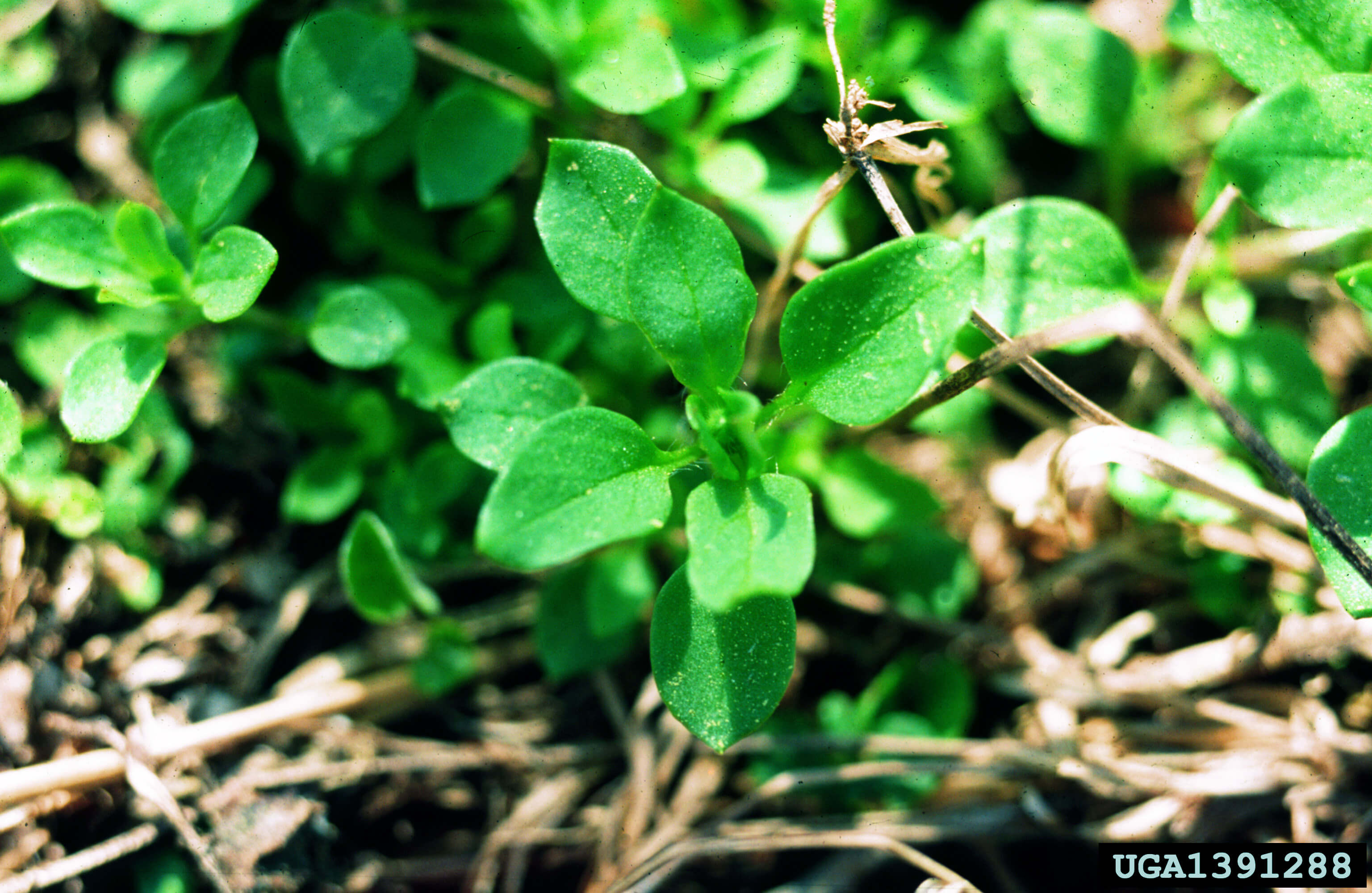 Figure 48. Common chickweed plant. Photo courtesy of John D. Byrd, Mississippi State University, Bugwood.org.
Figure 48. Common chickweed plant. Photo courtesy of John D. Byrd, Mississippi State University, Bugwood.org.
 Figure 49. Common chickweed flower.
Figure 49. Common chickweed flower.
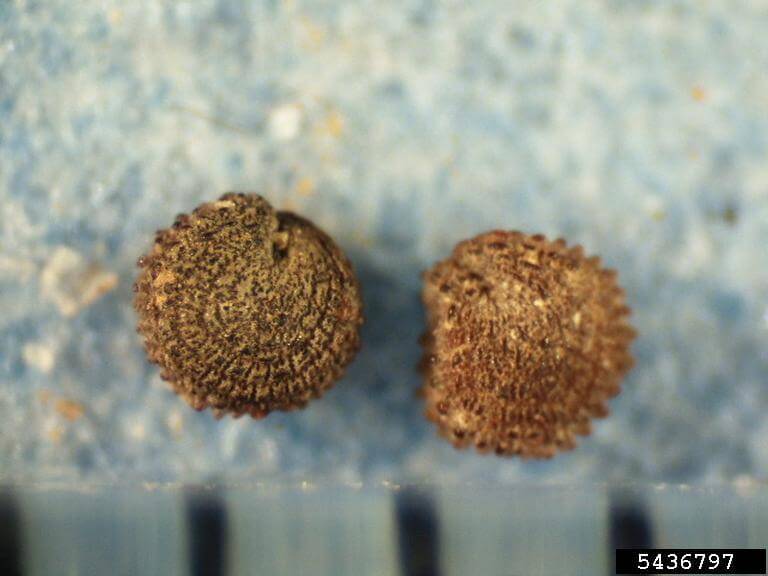 Figure 50. Common chickweed seeds. Photo courtesy of Bruce Ackley, The Ohio State University, Bugwood.org
Figure 50. Common chickweed seeds. Photo courtesy of Bruce Ackley, The Ohio State University, Bugwood.org
Reason for concern: Chickweed is of particular concern in Alberta where it is ranked 1st for relative abundance.1 Chickweed is also increasing in relative abundance in Manitoba, though in Manitoba and Saskatchewan it is ranked 18th.2,3 Group 2 (ALS inhibitor) resistant chickweed grows in all Prairie Provinces.4
Identification: Common chickweed is a winter annual that can have several generations per year during cool, wet seasons, and forms prostrate, dense mats. Common chickweed leaves are opposite, light green, rounded to egg-shaped, with pointed tips, smooth margins, and hairless or with a few hairs near the base (Figure 49). Common chickweed has a single straight row of hairs along the stem. Lower stems often root at the nodes.
Small, white flowers are borne in clusters at the end of stems. Flowers have 5 deeply-notched petals, resembling a pair of petals, and though small, are quite noticeable (Figure 50). Fruit are slightly curved, oval capsules that contains many tiny, brown seeds (Figure 51).
Management: Heavy infestations of common chickweed are competitive with crops, especially in small grains. Tall wheat cultivars and denser plant populations can help suppress chickweed. Tilling in the fall prior to wheat planting can help give wheat a head start. Common chickweed should be controlled prior to planting in no-till systems. A fall herbicide application can effectively reduce weed populations from overwintering and help reduce the number of seeds set in the spring. In addition, chickweed can serve as an alternate host for a range of crop pests including wireworm, black cutworm, and soybean cyst nematode and should have a plan for effective weed management.
Similar species: Common chickweed is similar in growth habit and appearance to mouseear chickweed (Cerastum fontanum ssp. vulgare). Mouseear chickweed differs by having a perennial habit with densely hairy, oblong leaves lacking petioles, and dark-green foliage (Figure 51).
 Figure 51. Mouseear chickweed is similar to common chickweed but has densely hairy leaves and a perennial growth habit. Photo courtesy of Theodore Webster, USDA Agricultural Research Service, Bugwood.org.
Figure 51. Mouseear chickweed is similar to common chickweed but has densely hairy leaves and a perennial growth habit. Photo courtesy of Theodore Webster, USDA Agricultural Research Service, Bugwood.org.
Sources:
1 Leeson, J.Y., Hall, L., Neeser, C. Residual weed population shifts in Alberta- 1973 to 2017. Agriculture and Agri-Food Canada.
2 Leeson, J.Y. Saskatchewan weed survey of cereal, oilseed and pulse crops 2014/15. Agriculture and Agri-Food Canada.
3 Leeson, J.Y., Gaultier, J., Grenkow, L. Residual weed populations shifts in Manitoba- 1978 to 2016. Agriculture and Agri-Food Canada.
4 Heap, I. 2021. The international survey of herbicide resistant weeds. http://www.weedscience.org
Web sources verified 4/22/2021
Common name:Barnyard grass
Scientific name: Echinochloa crus-galli L.
Life Cycle: Summer annuall
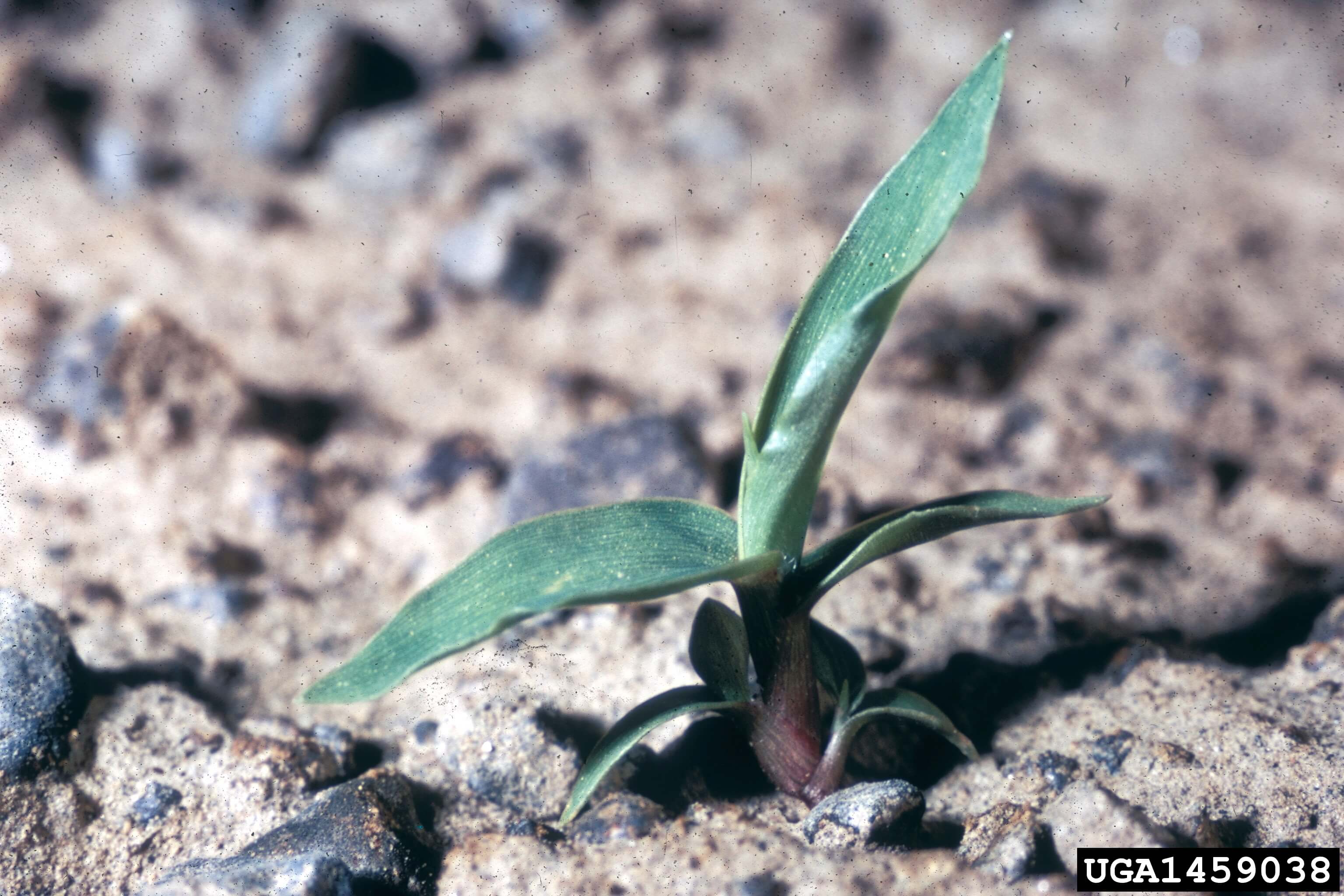 Figure 52. Barnyard grass seedling. Photo courtesy of Steve Dewey, Utah State University, Bugwood.org.
Figure 52. Barnyard grass seedling. Photo courtesy of Steve Dewey, Utah State University, Bugwood.org.
 Figure 53. Barnyard grass collar region. Photo courtesy of Bruce Ackley, The Ohio State University, Bugwood.org.
Figure 53. Barnyard grass collar region. Photo courtesy of Bruce Ackley, The Ohio State University, Bugwood.org.
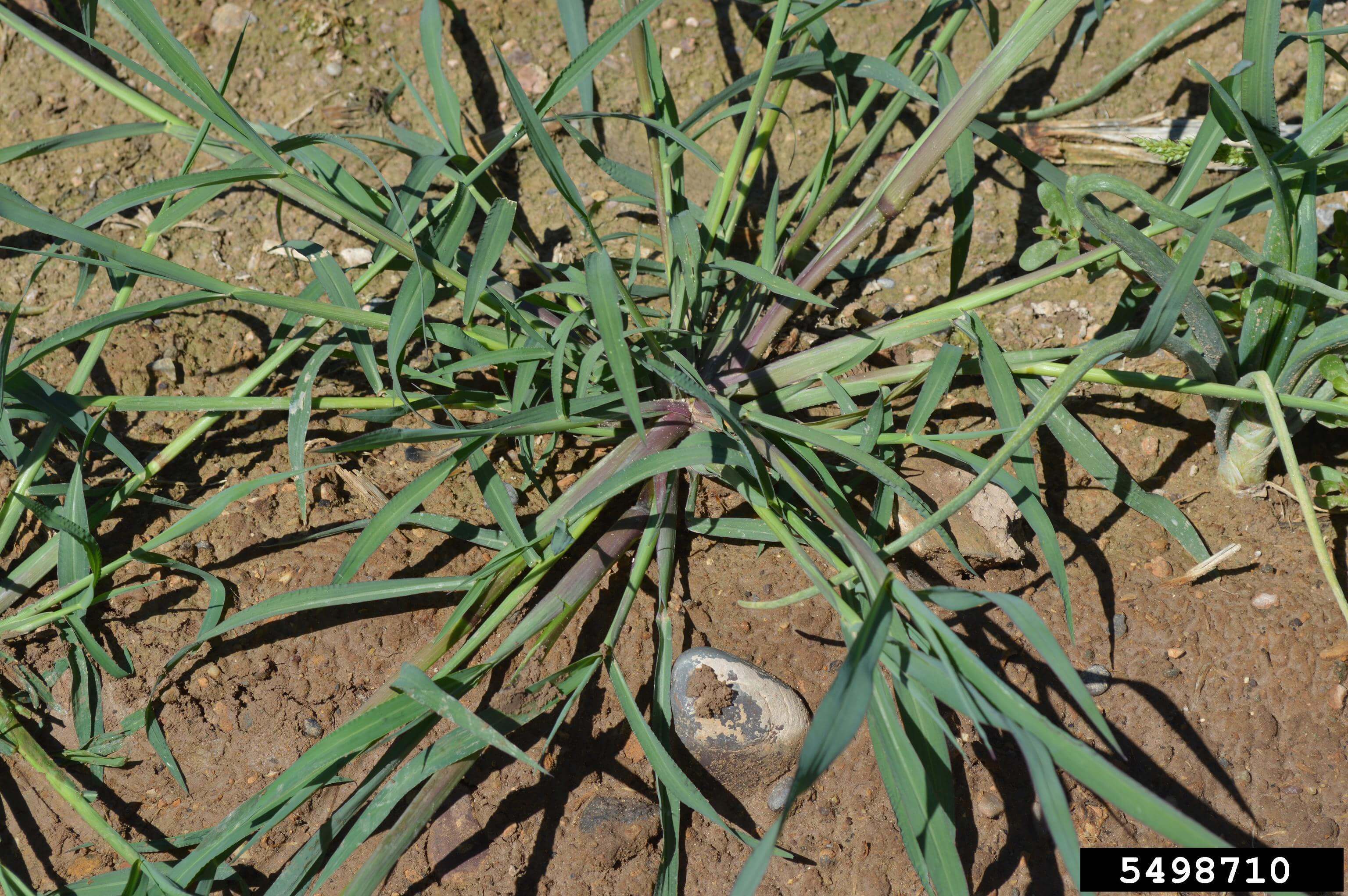 Figure 54. Barnyard grass plant base tinged red to maroon. Photo courtesy of Howard F. Schwartz, Colorado State University, Bugwood.org.
Figure 54. Barnyard grass plant base tinged red to maroon. Photo courtesy of Howard F. Schwartz, Colorado State University, Bugwood.org.
 Figure 55. Barnyard grass seed head. Photo courtesy of Howard F. Schwartz, Colorado State University, Bugwood.org.
Figure 55. Barnyard grass seed head. Photo courtesy of Howard F. Schwartz, Colorado State University, Bugwood.org.
Reason for concern: Barnyard grass is of particular concern in Manitoba where it is ranked 3rd for relative abundance.1 Group 2 (ALS inhibitors) herbicide resistance is also found in barnyard grass in Manitoba.2
Identification: Barnyard grass is a summer annual with thick stems that may reach 1.5 m (5 feet) in height.3
Seedlings are without hairs (glabrous), auricles, and ligules, and the leaf sheaths are often tinted red or maroon at the base (Figure 52). Leaves are rolled in the shoot, smooth and without ligules or auricles and have a distinct white midvein that becomes keeled toward the basal potions of the leaf (Figure 53). A few short hairs may occur at the leaf bases of mature plants. Stems are usually erect, thick, without hairs (glabrous), often branched at the lower nodes, and may be tinted red to maroon at the base (Figure 54). Seed heads are a terminal panicle ranging from 10 to 40 cm(4 to 16 inches) in length (Figure 55). Panicles may be green to purple in colour and are comprised of individual spikelets that may develop a 2 to 10 mm (0.08 to 0.4 inch) long terminal awn.
Similar Species: Fall panicum (Panicum dichotomiflorum) and barnyard grass are often confused prior to seed head formation due to their similar growth habit and appearance. However, the characteristic absent ligule of barnyard grass helps to distinguish this weed from most other grasses in both the seedling and mature stage of growth.
Management: Glyphosate reliably controls barnyard grass. Rotating crops and herbicide sites of action as well as utilizing residual herbicides and tank-mixing wherever possible are excellent resistance management techniques.2
Sources:
1 Leeson, J.Y., Gaultier, J., Grenkow, L. 2016. Manitoba weed survey annual crops 2016. Agriculture and Agri-Food Canada.
2 Manitoba Agriculture and Resource Development. Guide to field crop protection 2020. Prepared by Manitoba Agriculture and Resource Development in co-operation with Saskatchewan Agriculture.
3 Bond, J. and Golden, B. March 29, 2016. Barnyardgrass management in Mississippi Delta. Mississippi Crop Situation. Mississippi State University Extension. http://mississippi-crops.com http://mississippi-crops.com.
Web sources verified 4/22/2021
Legal Statements
Performance may vary from location to location and from year to year, as local growing, soil and weather conditions may vary. Growers should evaluate data from multiple locations and years whenever possible and should consider the impacts of these conditions on the grower’s fields.
Tank mixtures: The applicable labeling for each product must be in the possession of the user at the time of application. Follow applicable use instructions, including application rates, precautions and restrictions of each product used in the tank mixture. Bayer has not tested all tank mix product formulations for compatibility or performance other than specifically listed by brand name. Always predetermine the compatibility of tank mixtures by mixing small proportional quantities in advance. ©2021 Bayer Group. All rights reserved. 1027_S2